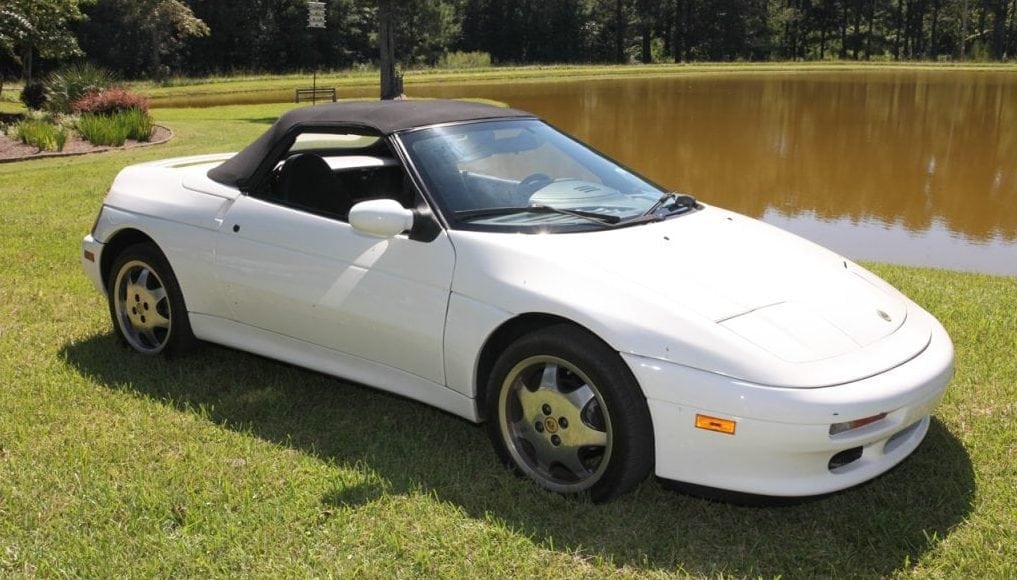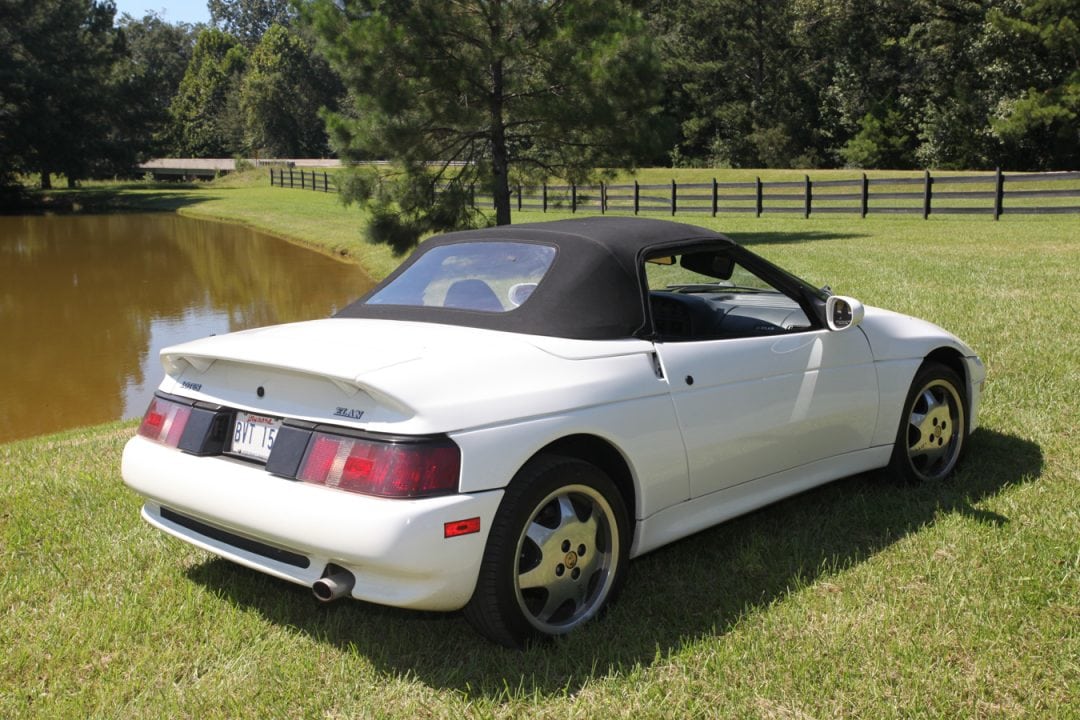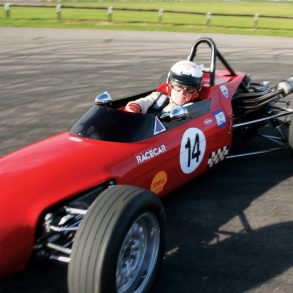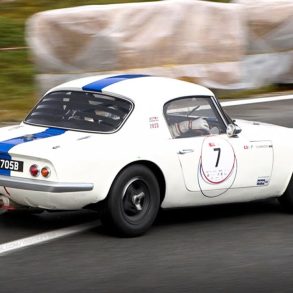Long ago when racecars used tires with tread, I owned a couple Lotus cars. While stationed in Germany, I bought a 1968 Lotus Europa and picked it up at the factory. After returning from Vietnam, I bought a 1956 Lotus 11 LM that I raced in the early ’70s. Then I got into Alfas. But the Lotus lust never left me.
While planning my car adventures for 2017, I made a list of cars I’d like to cover for this magazine. The list included the Lotus Elan +2, which I consider to be one of the prettiest Lotus cars ever. I was able to find two, gathered information and photos for an article, then attended the Lotus Owners Gathering in Birmingham, Alabama (Click here to view). After that, I was on the hunt for another Lotus.
One of the models I saw in Birmingham that interested me was the later Elan, the M100. Odd for a Lotus, since it was front-wheel-drive, but owners seemed enthused about their cars. When I saw one for sale in Atlanta, not too far from me, I started doing my homework. Schedules interfered with my seeing that car, so while sorting that out, I called a friend, Mike Glore, who has a number of Lotus cars, including an M100. I wanted to ask Glore about his impression of the car. He bought the car new and gave me a rundown on it. Then he hesitated before telling me that he was considering reducing his collection, and the M100 might be for sale. By the end of our conversation, I had arranged to see the car a couple weeks later, and it came home with me.
The M100 is possibly the most developed Lotus street car ever. The development was so involved, Mark Hughes wrote a book, “Lotus Elan,” about it. It took nearly 10 years from the decision to return Lotus to its roots, until the M100 was produced.
Chapman had taken Lotus up-market in the 1970s, but there was enough pressure in-house, especially by chief engineer Mike Kimberley, to develop another small sports car that Chapman relented. Development of the rear-wheel-drive M90 began using Toyota components. Financial issues temporarily stopped the development until Toyota became an equity partner in 1982. The M90 was taken to the prototype stage, but there had been a parallel effort at Lotus to design a front-wheel-drive sports car, designated the X100. Eventually, the M90 was dropped when arguments that front-wheel-drive was the thing Lotus needed won out. There were definite advantages in packaging of the engine and in the number of potential power units available. There followed a considerable development effort that even used a Corolla “Mule.”
Late in 1985, two of the main shareholders of Lotus pulled out, leaving the company in financial difficulty. Lotus needed a big partner, and GM became that partner in January 1986. Toyota took a dim view of this development and took their engines back. That left Lotus looking for another power unit, and they found it in the Isuzu 1600-cc turbo, DOHC, four-cylinder.
So, the X00 became the M100 – a small two-seat sports car that was designed to save Lotus. Production began in 1989, but it only lasted until 1995, when Lotus moved on to other models under new owners.
Driving/Owning Impressions
I’ve owned several front-wheel-drive cars, starting with a 1984 Dodge Caravan. I can’t say I was impressed with the handling of that car. I avoided front-wheel-drive, until I was seduced by an SVT Focus in 2002 and a Focus ST in 2013. What a difference they made in my opinion of front-wheel-drive. As a result, I wasn’t as jaded about front-wheel-drive as I was in the last century. Still, I expected some typical front-wheel-drive issues like torque steer to be very apparent. Glore led me to a nice twisty road near his place in central Mississippi to test the car. First, he drove it with me in the passenger seat. I was impressed with the lack of lean in the corners, the nice acceleration, and, of course, the brakes when he demonstrated the car’s talents. Then it was my turn.
This is not a big car, but I found it relatively easy to enter, even with a bad hip. The seats are very comfortable and have great lateral support. At first, I thought I might want more adjustment, but after a little fiddling, I was happy to be back where I started. Sitting in the car, my only complaint was the use of red in the gauges – in bright sun, they can be a bit difficult to see well. I forgot all about that after I started the car and moved down the road. The shifter is perfectly placed, and the shifts are precise and smooth. Acceleration, when a couple extra atmospheres of pressure are added via the turbo, just flat made me break into a wide-mouth smile. For only 160-hp, this car flies because of its weight, or lack of it. Then there were the curves, and I would have broken into my happy dance had I not been tucked nicely into the car’s seats. Yup, it’s a Lotus! I wrote the check soon after the drive.
As for ownership, it’s a Lotus, not a Toyota, so it will require some attention. But Glore was a competent first owner – he bought the car new in 1992 – so I became the second owner of a very well maintained Lotus Elan M100. It came with a treasure trove of manuals, parts lists and information that will make it less of a puzzle. And it is so much fun to drive, not to mention show off. The car won the Lotus class at the Southern British Car Club annual British car show in October 2017, and I suspect it will win other prizes. But its biggest prize will come when I have recovered fully from my hip replacement and take it to the “Tail of the Dragon” – 318 corners in 11 miles. That’s where this car belongs, and that’s where she’s going to go.
I have finally satisfied my car lusts. The M100 joins my 1973 Alfa Giulia Super in my garage, and I’m a very happy camper. No need to look for anything else, right? Oh look, the new Hemmings Motor Newsjust arrived…hmmm.
Specifications
Body: Multi-piece bonded, riveted, and bolted VARI-moulded GRP composite
Chassis: Steel backbone
Engine: DOHC Turbo I-4 Isuzu
Displacement: 1588-cc, 96.9-cu.in.
Bore/Stroke: 80.0-mm /70.0-mm
Power (Turbo with cat): 160-hp @ 6000 rpm
Torque (Turbo with cat): 150-ft-lbs @ 4200 rpm
Transmission: 5-speed, all synchro
Suspension: Independent
Steering: Rack and pinion
Brakes: Front – ventilated 10 inch disks; rear – solid 9.3 inch disks
Wheels: Lotus 6.5J x 15 cast alloy
Length: 152.4-inches, 3872-mm
Width: 74.3-inches, 1885-mm
Height (top up): 48.4-inches, 1230-mm
Weight: 2392-lbs, 1085kg
Fuel consumption: 26.4/40.6/31.7 mpg
Valuation
MSRP (1991) $33,900
Fair: $11,200
Good: $15,800
Excellent: $20,100
















